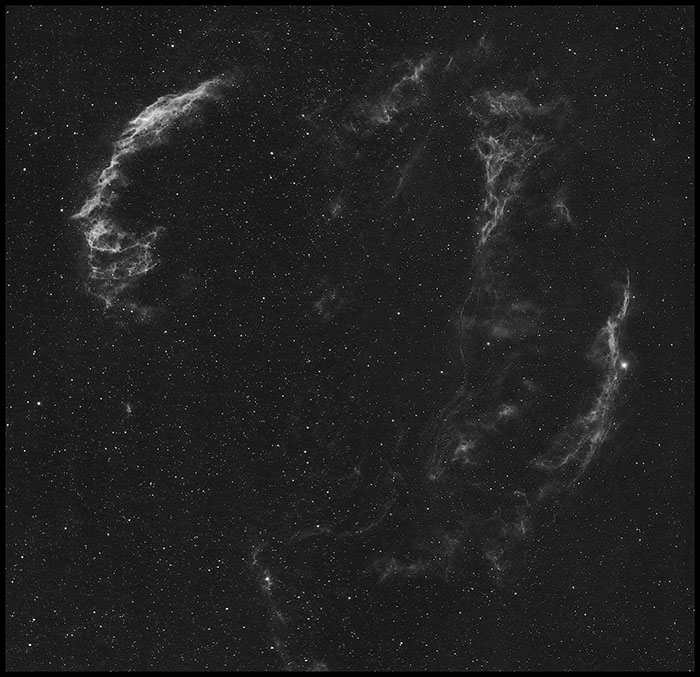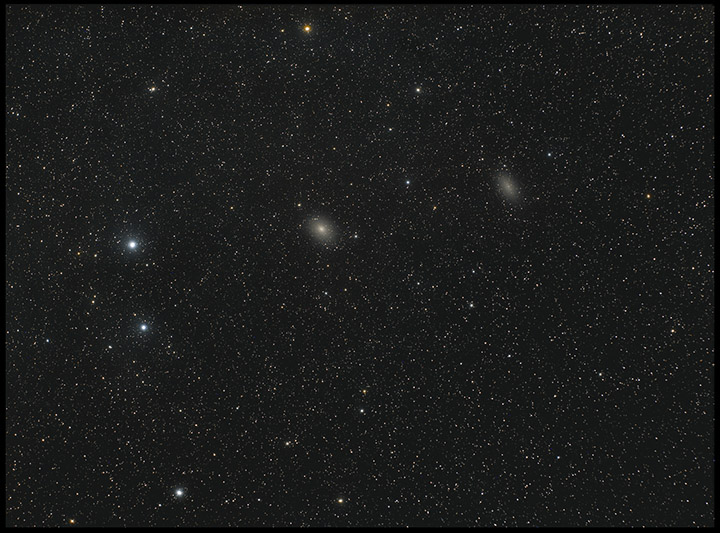In the Moonlight
10/09/2016. The Canon 50D connected up just fine with Backyard EOS. I've been checking batteries most of the day, charging all I can find and seeing which ones still hold a charge. That's for the eclipse (315 days). Tonight I used the AC power supply. I started with four 600-sec darks at ISO 1600 in preparation for hydrogen-alpha imaging through growing moonlight. The air is that clear, fresh oceanic air that often follows a hurricane (so long, Matthew).
I focused on Vega by minimzing the FWHM of the star's PSF using Backyard EOS and the Baader Fringe Killer filter which is, I think, of the same optical thickness as the O-III and H-a filters but vastly easier to see through. I calibrated PHD-Guide while taking darks and waiting for the night's subject to clear Birdfeeder Tree. I slewed to NGC 6960 (the western Veil), counted off 18 seconds at 12x sidereal back to the east, took 60-second snapshots to adjust composition and to wait for the field to enter unobstructed sky, and then began a series of twelve 600-second exposures inlcuding the western Veil and central filaments.
When I came inside Amy was sitting at her computer. "How's it going?" she asked. "So far, so good," I said. "You're taking widefield hydrogen-alpha images in Cygnus tonight, right?" she said. "Wow!" I said, "Yes I am! That's pretty good..." "Yeah," she said, "you're taking pictures of Gowannadonda."

Gowannadonda
600 sec x 12, twice. 2 hours x two.
Hap Griffen modded 50D, ISO 1600
Baader 7nm H-a filter
TMB92SS & TeleVue TRF-2008
Click the picture to see the fainter bits better.
After completing the 2 hour sequence of the western Veil, I counted off another RA offset, 20 seconds more at 12x sidereal. Then I repeated the 2-hour sequence series to capture the eastern arc. (The Pixinsight forum provided some key points about post-processing H-a data from a modified DSLR. I've added them to the workflow posted several weeks [uhm, one year ago!]. See here.)
The sky, now Moonless, was too good to waste, so I exchanged cameras on the TMB92. The 50D is shooting additional 600-second ISO 1600 darks (body cap, intervalometer, AC power) while the 6D takes 180-second ISO 1600 white light exposures of NGC 185 and 147, M31's outlying satellite galaxies (Kendrick battery pack, under Backyard EOS control).
All went perfectly (head lamps are great!) except that I apparently forgot to hit "go." The only image of the two small galaxies on the computer or on the camera was a preview snapped to confirm aim. I intended to give this field about 250x this exposure. See those two really faint fuzzballs? No? They're there if you know where to look. Next time.

NGC 185 & NGC 147
1x60s ISO 6400
Canon 6D / TMB92SS @ F4.4
10/10/2016. More moonlight, lots more clouds, but I set up for an overnight run on those two distant satellite galaxies of M31 anyway. I never saw a star fainter than 3rd magnitude, and most of the night was worse. The DSI/50mm guider hung in nicely, and I took ninety 180 second exposures at ISO 1600 throughout the night. A rainbow of sky colors! Orange skies, magenta skies, yellow skies. But stars in every frame. I picked the best 45 and processed them using Pixinsight. This is what I had in mind, haze, moonlight, and clouds be damned:

NGC 185 & NGC 147
45x180s (2h15m)
6D @ ISO 1600
TMB92SS @ F4.4
Go on, you know you want to click it.
Note that I only kept a few representative frames from the night's raw data. That image was more or less a stunt: what can you do with lackluster, 2nd and 3rd magnitude skies if you have a pile of data to work with? Quite a lot, actually. The photo shows stars to just below 14th magnitude (25,000x fainter than those I could see in last night's sky and about a thousand times fainter than the faintest stars visible even on a great night).